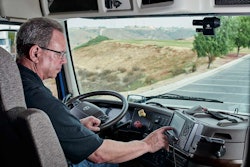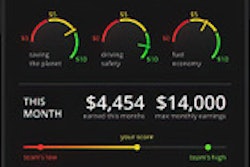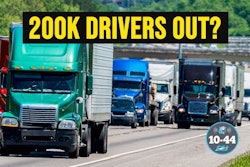If you’re out driving, all you have to do is look around at your fellow drivers to see how big of a problem distracted driving has become.
The National Highway Traffic Safety Administration’s latest traffic fatality data found that more than 3,300 people were killed in crashes involving distracted driving in 2022. Distracted driving is not only limited to passenger car drivers, either. Whether it’s cell phone use, eating and drinking, or some other form of distraction, truck drivers can at times take their eyes off the road.
Teletrac Navman recently released the results of a survey of its customers about how big of an impact distracted driving has on fleets, and what those fleets are doing to solve the issue.
Contents of this video
00:00 10-44 intro
00:21 Truck drivers and distracted driving
01:38 What is distracting truck drivers?
03:13 Direct costs and operational disruptions of distracted driving
04:12 Adoption of technology
06:07 Cultural shift of driver-facing cameras
Matt Cole:
Distracted driving continues to create havoc on the highways. How are trucking fleets working to combat that trend?
Jason Cannon:
You're watching CCJ's 10-44, a weekly web episode that brings you the latest trucking industry news and updates from the editors of CCJ. Don't forget to subscribe and hit the bell for notifications so you'll never miss an installment of 10 44. Hey everybody, welcome back. I'm Jason Cannon and my co-host is Matt Cole.
If you're driving around, all you have to do is look around you to see just how big of distraction has become for your fellow drivers. The National Highway Traffic Safety Administration's latest traffic fatality data found that more than 3,300 people were killed in crashes involving distracted driving in 2022.
Matt Cole:
Distracted driving is not only limited to passenger car drivers either, whether it's cell phone use, eating and drinking, or some other form of distraction. Truck drivers can at times take their eyes off the road too. Telematics firm Teletrack Navman recently released the results of a survey of its customers about how big of an impact distracted driving has on fleets and what those fleets are doing to solve the issue.
Carlos Caponera:
So with the distracted driving report that we launched earlier this year, we really found that about 70% of those fleets we surveyed and we surveyed about 241 fleets globally across different regions, mostly in the US and Australia, but we also have fleets around the globe in Latin America and in Europe. But out of those fleets, 70% came across that saying that they were highly affected by distracted driving, which is a natural issue happening across the board for a while. Now, within these industries,
Jason Cannon:
As Carlos mentioned, more than two thirds of fleet said distracted driving is a major problem for them. But what are those distractions?
Carlos Caponera:
Well, it is a serious kind of issue facing the industry today. What we found from the survey was about 68% of those distracted were really distracted by their phones. As incap technology emerges and grows, we're seeing more and more of our drivers having to access phone either for routing, for dispatching, for communications, et cetera. And so we're seeing a high propensity of them grab their phone or look at their phone and kind of get updates as they're on the road, which is very dangerous as we all know. I mean, us just driving our day-to-day vehicles face that as well, but it's especially a serious situation with kind of the large vehicles that we service day-to-day. The other thing that we found, and this is a common one that's always been there, is eating and drinking on the road, right? So whether they got to meet their commitments and their ets. So we did see, we've seen videos of drivers eating and drinking at the same time in their vehicles trying to get to their destination, and the one that really is emerging that we are seeing as well is infotainment. So whether they are distracted by, in some cases having their phone connected to a streaming service and either having a movie on or some sort of news or tv, which is very distracting and it's beyond my belief that some drivers actually do that day-to-day.
Matt Cole:
Distracted driving affects fleets in several ways, including direct costs, operational disruptions, and more.
Carlos Caponera:
We want to make sure that the drivers come home safe and our objective is to reduce traffic incidents and accidents. But there are costs both for the company direct costs in terms of how it affects issues such as accidents, whether they're kind of fender benders or major wrecks. That does affect not only the cost to replace and make good at what happened there, but also reputational damage. We've seen some big brands get into major accidents that cause fatalities, and that also has a direct impact on the reputation. But overall, some of these distracted driving incidents do cause operational disruptions. We did see 40% there of the survey coming back saying that it does have major disruptions in their ability to deliver on time and within the expected window there.
Jason Cannon:
One way fleets are addressing distracted driving among their own employees is through the adoption of technology.
Carlos Caponera:
I think a lot of us are familiar with the technologies at Hand Trek. Navman does have a safety suite of features and capabilities to help to reduce distracted driving and encourage positive driving behavior. That is something that the industry is taking on, and more and more we're seeing adoption of that type of technology, and it stems everything from driver scorecards. So being able to understand within the framework of our application, harsh braking, harsh cornering, these are all signals of possible distracted driving or defensive driving. So when we look at that, we say, okay, well, was the driver doing a harsh break because somebody cut him off? And in the report, you can't really read into that. We have analytics that lend to a possible understanding what occurred there, but then you move into video telematics or the technology that allows you to see both in cab to see if the driver's being distracted as we talked about with drinks or if they're looking at their phone.
But we also have forward facing and side facing cameras that allow you to see what's happening around the vehicle and within that framework that you can get a pretty good picture of what happened. Right? So you see within the application within TN 360, our platform, our telematics platform, you can see a harsh event occurred, but then when you pull up the video besides it, you can actually see that somebody cut off the truck driver and he had to brake in order to prevent an accident. So that to us is a positive aspect of this technology. And as I said, globally, a lot of fleets are taking a look at the technology. They've already started adopting it, and they're even further going into using that technology to help them coach and support positive driving behavior that we should all be looking at as fleet managers
Matt Cole:
For fleets that have trouble getting buy-in from drivers on driver facing cameras, Carlos says there is a cultural shift that is taking place and needs to continue taking place in trucking to get that buy-in.
Carlos Caponera:
A cultural change that has been taking place and has advanced greatly. So I think today a lot of fleet managers and drivers within fleets recognize that this technology isn't harming them or isn't kind of pointing out issues. It's actually helping them become better at their trade. We all have those nuances where we may look at our phone, we may not be paying attention, we may be distracted here or there, but this technology does help. There's a lot of cultural change. I think having the visibility to not only look at the negative aspect of what happens on the road, but as I said before, positive behavior that really should be encouraged and really highlighted within the driver and the fleet manager, because those are the things that help increase driver safety and promotes a better culture, in my opinion, versus the negative side of the technology as it's been seen in last pass.
But that kind of approach of it being in an intrusive, people are seeing me in my workplace. I think that kind of trend has changed a lot. There are some regions that are still adopting it, but in the US and in Australia for example, we don't hear much about that. What we do hear from our customers is how do we encourage the training and the focus and the coaching between the driver and the fleet manager, the safety manager? That's where we're seeing a lot of improvements and a lot of demand from the field on how do we create better driving coaching scenarios? How do we set the expectations? How do we reward great driving, right? That's the other emerging requests that we're seeing from our customers.
Jason Cannon:
That's it for this week's 10 44. You can read more on ccj digital.com. While you're there, sign up for our newsletter and stay up to date on the latest and trucking industry news and trends. If you have any questions or feedback, please let us know in the comments below. Don't forget to subscribe and hit the bell for notifications so you can catch us again next week.











